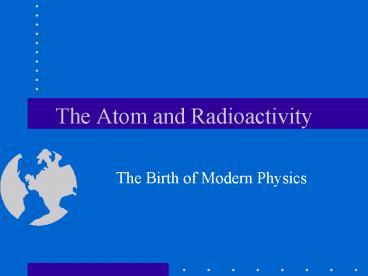The Atom and Radioactivity - PowerPoint PPT Presentation
1 / 16
Title:
The Atom and Radioactivity
Description:
... stable again, they must emit a particle (decay) ... Some nuclei decay by emitting ... half of the atoms in a radioactive sample to decay is the half-life ... – PowerPoint PPT presentation
Number of Views:179
Avg rating:3.0/5.0
Title: The Atom and Radioactivity
1
The Atom and Radioactivity
- The Birth of Modern Physics
2
Basic Structure of an Atom
- An atom consists of negatively charged electrons
surrounding a positively charged nucleus - The nucleus consists of both positively charged
protons and neutral particles called neutrons
3
Properties of Atoms
- An atoms always has the same number of electrons
and protons - The number of protons in the nucleus of a
particular atoms is its atomic number - Example Carbon atoms have six protons so the
atomic number of carbon is six - The atomic number determines the chemical
properties of an atom
4
The Nucleus
- The nucleus consists of a dense ball of neutrons
and protons - The total number of neutrons and protons is the
atomic mass - Protons and neutrons are roughly equal in mass,
but they are almost 2000 times more massive than
the electron
5
Discovery of the Electron
- In 1897, J.J. Thompson discovered the electron
- The electron is a negatively charged particle
that is thousands of times lighter than the
lightest atom
Thompsons experiment to prove that electrons are
light, negatively charged particles
6
Isotopes
- Isotopes have the same atomic number but a
different atomic mass - That is, the number of protons is the same, the
number of neutrons is different - Example Hydrogen has three isotopes called
hydrogen, deuterium and tritium (each has only
one proton)
7
Notation
- Sometimes, the atomic mass of an isotope is
indicated after the name of the element, e.g. - uranium-238
- carbon-14
- Sometimes, the atomic mass is written as a
superscript preceding the symbol for the element,
e.g. - 238U or 14C
8
Radioactivity
- In the late 19th century, Becquerel and Marie and
Pierre Curie discovered that certain elements
emit radiation - Definition Radioactivity is the property of
elements that emit radiation - Definition Radiation is the stream of particles
that are actually emitted from a radioactive
substance
9
Types of Radiation
- Unstable nuclei emit three common types of
radiation - ? rays heavy positive charge
- ? rays light negative charge
- ? rays neutral particles
?
10
What Causes Radiation?
- Certain isotopes have unstable nuclei
- In order to become stable again, they must emit a
particle (decay) - Example Tritium is unstable and emits a beta
particle (electron)
11
Alpha Radiation
- Some nuclei decay by emitting an alpha particle
- An alpha particle consists of two protons and two
neutrons (i.e. a helium nucleus) - Example Americium-241 (241 atomic mass)
becomes Neptunium-237 after emitting an alpha
particle
12
Discovery of the Nucleus
- Rutherford, Geiger and Marsden observed that most
alpha particles passed straight through a gold
foil (1911) - Occasionally, a particle was deflected as it
struck the nucleus
13
Beta Radiation
- Some nuclei decay be emitting a beta particle
- A beta particle is just an electron!
- When tritium decays, a neutron becomes a proton
and an electron is emitted
14
Gamma Radiation
- Some nuclei decay by emitting a gamma particle
- A gamma particle is just pure energy (a photon)
- Helium-3 has too much energy, so it emits a
gamma-ray photon
15
Comments on Radioactive Decay
- When an atom decays by alpha or beta radiation,
it transmutates or changes into a different
element - Example When uranium decays by emitting an alpha
particle, it becomes a thorium atom - Many radioactive elements decay into other
radioactive elements which themselves decay - Example Uranium will eventually decay into lead
through several intermediate decays (i.e. uranium
to thorium to protactinium ... to lead)
16
Half-life
- The time it takes half of the atoms in a
radioactive sample to decay is the half-life - Example Uranium-238 has a half life of 4.5
billion years - After 4.5 billion years, only half of the
original quantity of uranium will remain - After 9 billion years, only one fourth will
remain

